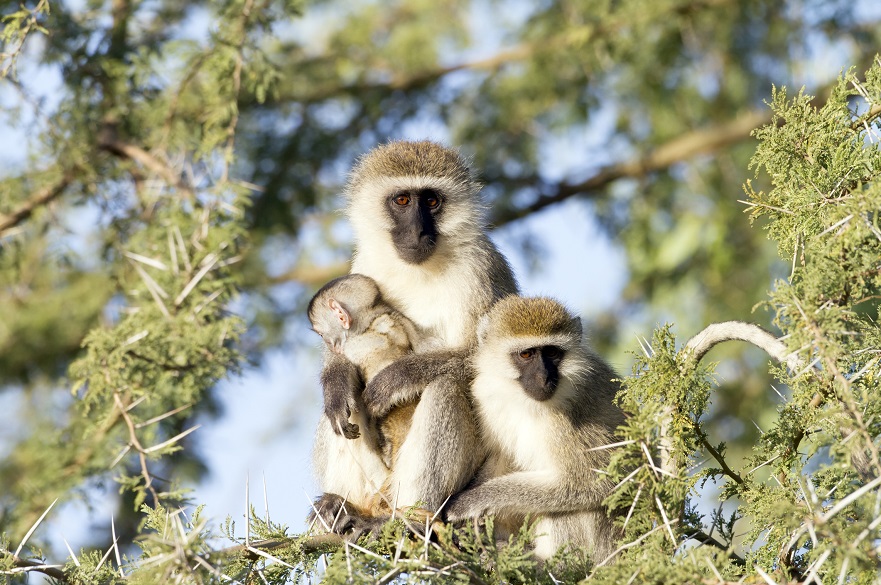Wild monkeys shown to give birth during optimal body and environmental temperatures
Wild monkeys may give birth at night to benefit from lower body and environmental temperatures, allowing them to better conserve resources and improve the welfare of mother and baby.
By Helen Breese | Published on 25 January 2022
Categories: Press office; Research; School of Social Sciences;

As part of a long-term study of wild vervet monkeys using state of the art bio-logging technology, research led by Nottingham Trent University has for the first time recorded the birth temperatures of wild primates.
The research tests traditional ideas of why monkeys who are active during the day have evolved to give birth at night. Nocturnal birth has long been seen as a strategy for predator avoidance or as a means for mothers to recover from birth and bond with the infant without interference by other monkeys or troop movements.
Over the course of seven years, 17 births which took place during an inactive night-time phase were analysed. Two daytime births were also witnessed and examined.
Birthing females were seen to experience lower night-time core body temperatures than non-birthing females and reached those temperatures earlier in the night. Birthing females also experienced lower temperatures during birth than they did during the night seven days prior.
For the two daytime births, researchers identified a drop in maternal body temperature before giving birth, immediately followed by a swift rise.
Dr Richard McFarland, senior lecturer in Psychology at NTU’s School of Social Sciences, has spent almost ten years studying the thermoregulation of primates in South Africa, including the impact of climate on their behaviour. He said: “Our findings suggest that there may be important thermal consequences linked to the timing of primate birth.
“We observed that a mother’s body temperature lowers at birth to create a cooler thermal environment that serves to protect the foetus from injury during hypoxic birth conditions. Immediately after birth is also a critical period for the infant, where the new-born can be at risk of hypothermia if they are born on a cold night, or at risk of hyperthermia if they are born during the heat of the day. The mother’s own physiology, and behaviour toward the infant, is essential during this period.

Dr Richard McFarland, Senior Lecturer in Evolution and Social Behaviour in the School of Social Sciences
“Giving birth at night maximises the thermal efficiency of the birth process, making it easier for the mother to lower her body temperature at birth, in conditions that tend to be cooler. It would be physiologically more challenging to give birth during the heat of the day, when the mother’s body temperature is naturally higher.
“In addition, during the night the mother doesn't need to implement evaporative cooling to lower her temperature and can instead rely on less costly dry heat loss. At a time when maternal resources are at a premium, any means by which resources can be conserved, and physiological processes made less costly, are likely to improve the welfare of both mother and infant.”
Vervet monkeys are also known consume the placenta after birth, which has previously been argued to replenish nutritional losses from pregnancy, reduce pain and prevent the placenta from attracting predators. The researchers now suggest that it may also provide the energy needed to recover temperature post-birth.
The findings of the study have wide-reaching implications both for the understanding of primate reproduction and human birth patterns and health risks.
Dr McFarland added: “It seems reasonable to suggest that the timing of birth will be particularly important for smaller, more thermally-vulnerable species, where birth should be more synchronized to the most thermally advantageous time. This may explain why apes are less committed to night-time birth than monkeys.
“Humans, like monkeys, tend to give birth more frequently at night, but not as routinely as other non-human primates. Greater flexibility in the timing of human births is likely a consequence of our reliance on medical intervention, including the typically cool artificial environments of birth places and a greater reliance on hospital births and medical intervention. Nonetheless, the risk of neonatal hypothermia, in particular, remains a significant cause of infant morbidity and mortality, especially in developing countries and during winter months.”
The paper The thermal consequences of primate birth hour and its evolutionary implications has been published in the Royal Society journal Biology Letters.
Notes for Editors
Press enquiries please contact Helen Breese, Public Relations Manager, on telephone +44 (0)115 848 8751, or via email.
About Nottingham Trent University
Nottingham Trent University (NTU) received the Queens Anniversary Prize for Higher and Further Education in 2021 for cultural heritage science research. It is the second time that NTU has been bestowed the honour of receiving a Queen’s Anniversary Prize for its research, the first being in 2015 for leading-edge research on the safety and security of global citizens.
NTU was awarded Outstanding Support for Students 2020 (Times Higher Education Awards). It was the University of the Year 2019 (Guardian University Awards, UK Social Mobility Awards), Modern University of the Year 2018 (Times and Sunday Times Good University Guide) and University of the Year 2017 (Times Higher Education Awards).
NTU is one of the UK’s largest universities, with over 33,000 students and more than 4,000 staff located across five campuses. It has an international student population of 4,000 and an NTU community representing around 160 countries.
In the past 15 years, NTU has invested £450 million in tools, technology and facilities.
NTU is in the UK’s top 10 for number of applications and ranked first for accepted offers (2019 UCAS UG acceptance data) It is also among the UK’s top five recruiters of students from disadvantaged backgrounds.
75% of NTU students go on to graduate-level employment or graduate-entry education / training within fifteen months of graduating (Guardian University Guide 2021).
NTU is 4th globally (and 3rd in the UK) for sustainability in the 2021 UI Green Metric University World Rankings (out of more than 900 participating universities).